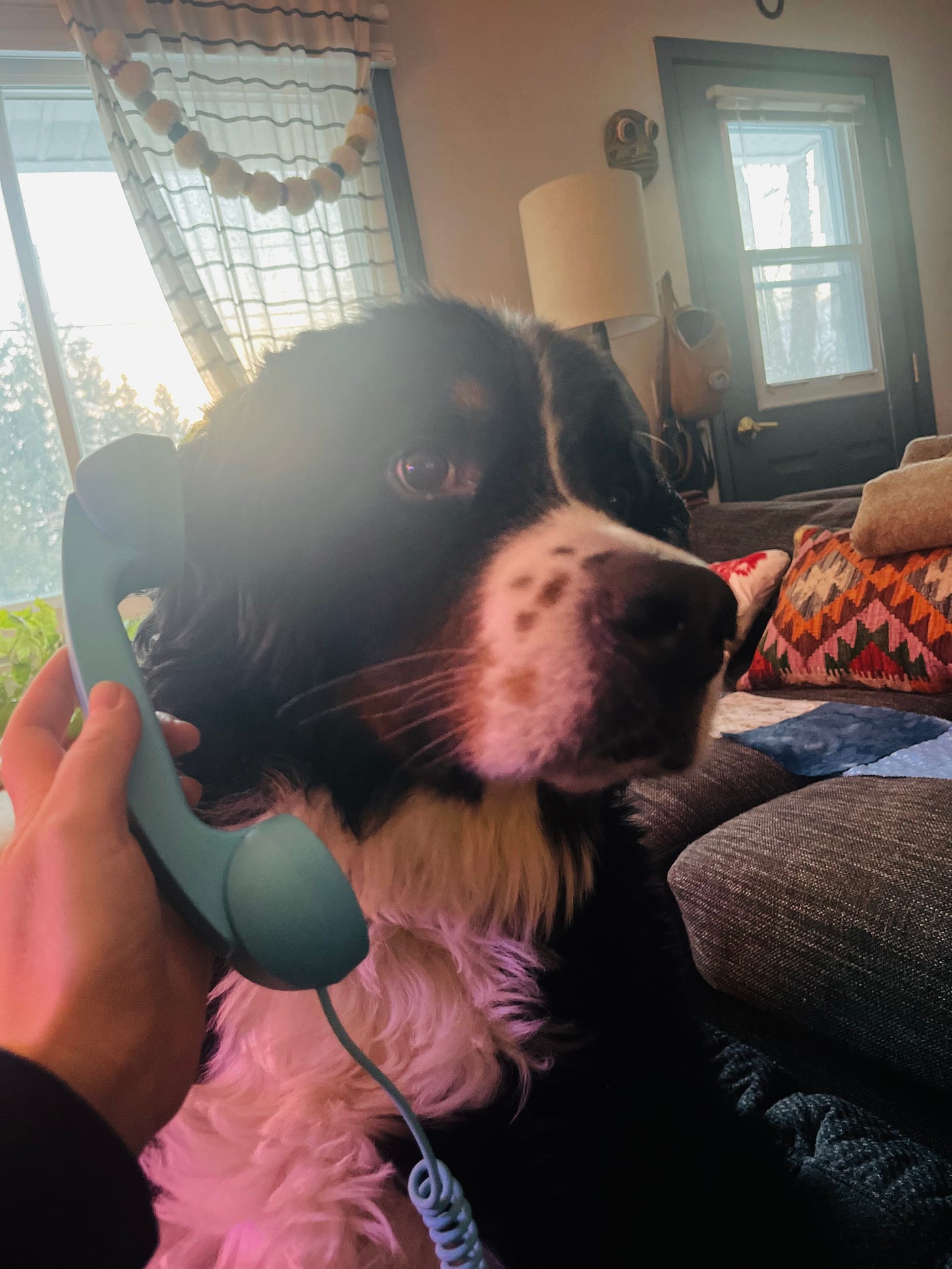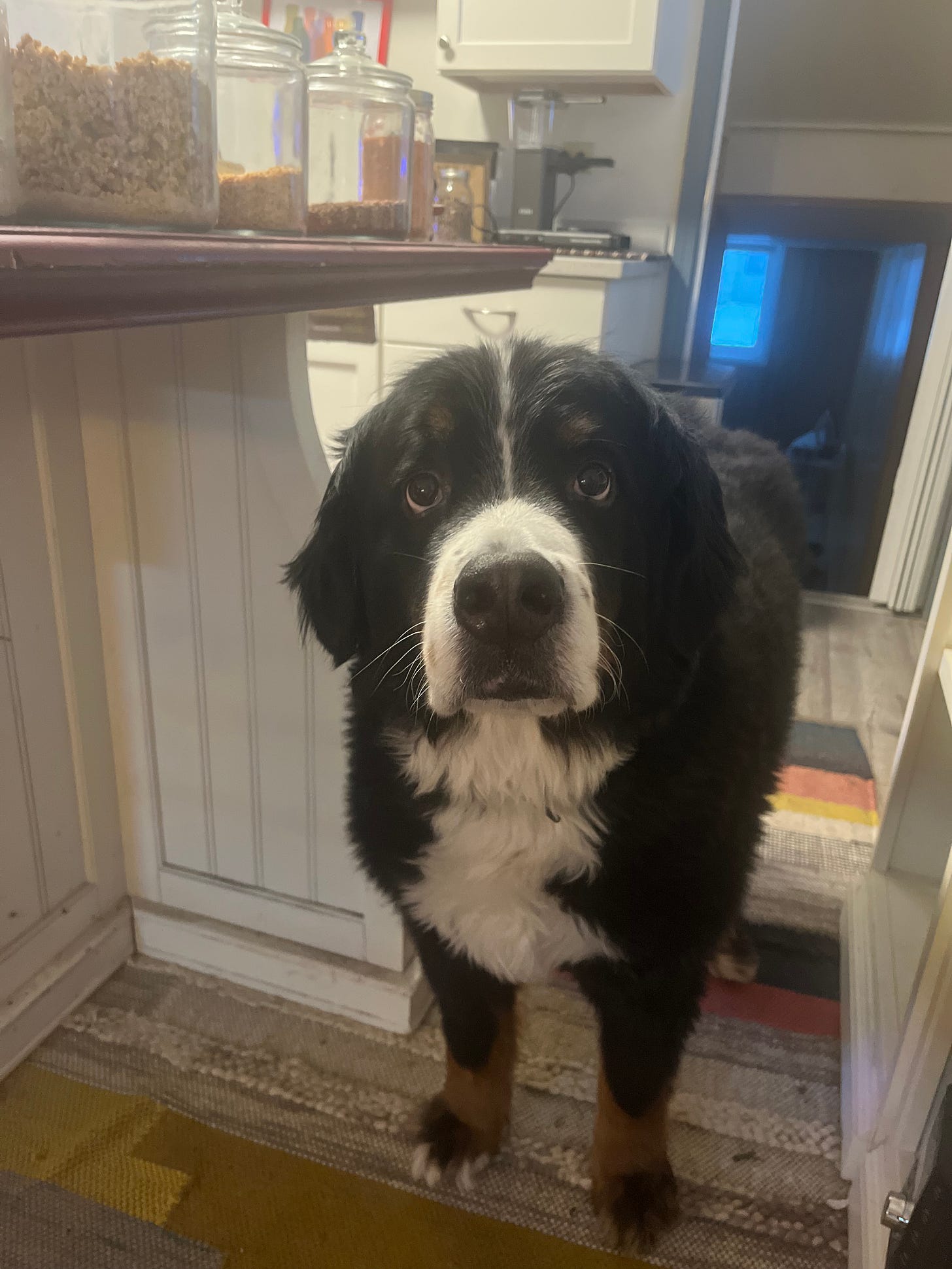Oh hello Dopamine Dogs.
There are other things going on in the world today, but one of the things happening here in Hamilton, New York is that it is the first day of school. Another thing that is happening here is that it was -3 degrees out this morning which delighted Mori but not me. It also prompted a university -wide email about how to limit skin exposure and minimize outdoor time.
I WOULD LIKE TO TAKE THE ROAD LESS TRAVELED TO PEE ON PRISTINE SNOW WILL MAKE ALL THE DIFFERENCE YOU SEE
Anyway. I’m back in the classroom after a long time away, and whenever it’s the first day of school I always think of the Welcome Back, Kotter theme song. No, I’m not that old. But I watched it religiously on Nick at Nite as a kid during the golden age of 90s Nickelodeon, and I am precisely this old.
The point is someone used to play the Kotter theme on the PA system at my high school on the first day of school every year which always made me feel feelings. It didn't hurt that I was totally devoted to Barbarino, John Travolta’s character, a man I wanted to buck. For more information on “bucking” — the act of not being sure if you want to BE or FUCK someone— please see the OG source, this Ali Kolbert podcast episode.
Here is Vinnie …
BUT WAIT! This isn’t supposed to be a murderboard of back to school nostalgia and theme songs! We have important business to attend to…we’re going to school babies….with:
DEAR DOPAMINE DOG
I CAN HEAR YOU CAN YOU HEAR ME YES YOU I HEAR BUT WHAT ABOUT ME?
Dear Dopamine Dog,
I’m trying to leap into fiction from poetry and wrestling with outlining a novella. A question I have for Dopamine Dog is how do you approach the process of prewriting, or laying out the grand narrative arc and beats of a book? Outline/no outline? I'm currently trying to organize via scenes on notecards but feel swamped by the process.
Dear Swamp,
Here’s the thing, I sort of think that whether or not a person needs an outline or not is just a matter of personal constitution. It’s sort of like being a morning lark person or a night owl person. It’s not really up to us. (I knew someone who, when forced to get up before ten am would say THIS IS VIOLENCE AGAINST MY CIRCADIAN RHYTHMS. And like, fair enough.)
Here, I’m talking specifically about in a novel or a novella, to be clear. But I think the way to answer this question for yourself is HOW DO YOU NEED TO TRICK YOUR BRAIN?
And believe me, we are all tricking our brains.
People who like outlines, IMO, need the illusion that there is a plan and that they are making progress toward a definable goal. The outline tricks them into enough safety and peace that their brains will shut up and write. Often they wind up throwing away the outline later.
People who like to write with no outline, which I like to call freewheeling, also need to trick their brains. They are tricking their brains that they don’t know anything about the characters or the world or the plot yet— it’s all possible! They’re not tied down to any plan or rules! If they felt they were committed to a plan they would panic and be unable to write. So they must trick their brains with the illusion of infinite freedom, and then their brains will shut up and write. Often they actually know more in advance then they let on.
So, which one am I, you ask?
Oh Dopamine Dogs, you didn't actually think I would give you a binary did you?
HAHAhahahahahaHAHAHAhahahahaHAHAHAHAHA. ha.
I am, of course, both.
The novel I am working on now I wound up mapping out chapter by chapter—but only after I’d written the first hundred pages and sort of gotten to know it. And for me, that’s because it’s a plot based book, and sort of a mystery, so figuring out the arc of the thing and structuring discoveries was key. I also got briefly Save-the-Cat-pilled during a rough time last winter and something about the order and predictability of the arc soothed me. Then it made me want to vomit. Then it soothed me again. Basically— if your life is chaotic and terrible sometimes a hack plot arc can bring you the illusion of peace. I’m not recommending this. Just noticing my own truth.
But I’ve never outlined a novel before this. Because mostly I need to trick my brain into thinking it’s playing, exploring, and…most importantly for me…that I CANNOT FUCK UP. If I have an outline? And I write something that diverges from the outline? OH no, says my nervous system. I did a bad.
BUT IF THERE IS NO OUTLINE? NO WRONG ANSWERS BABY.
And then my nervous system is calm and my brain thinks it’s playtime and I can go boop boop boop and make words happen. Which is, of course, THE WHOLE BAG.
What I HAVE done is the past is what some people call reverse outlining, but I think of as MAPPING. And yes, it involves index cards. And yes, anyone who has ever taken a class with me is now groaning because they have been tormented by these cards. What follows is the exercise I have students do in class:
Here’s what I do, once I have a fiction draft, or even a partial draft with a sense of what’s coming next…
-Lay out the structure of your story on the cards. What are the major scenes or beats? On the front of the cards write a shorthand for the scene or write a tiny list of the things that happen, externally, in that scene.
-On the back of the cards, now tell us what internal work that scene is doing in the story. You might think of the front being external and the back internal—or better yet- the front being WHAT HAPPENS, and the back being WHY IT MATTERS.
-Now…look at the cards. Consider the order of events and consider the order of FEELINGS or internal movements.
Does the order make sense to you?
Shuffle the cards around a little (painful, yes, but just do it) and see what reveals itself to you. Don’t worry about whether or not a shuffling is a good shuffling… just try moving things around and see what it feels like to consider the order of things in a new way. If the new order feels very wrong : why?? Use this process to get a sense of what it is the structuring of beats in your story are doing. Why is it important for the character that you start here, but wind up there?
Are there beats or moments that feel missing to get you from B —> E in this story? Slot them in on a new card!
If you did this… here’s what you might observe.
It’s very possible that either the fronts or the backs of your cards all say….the same thing.
IE, the front of the cards have many splendored things on them. Boat races and family arguments and choices and surprises! But then… all the flip sides maybe say the same thing. Character X is afraid of death. Character X is afraid of death. Character X is afraid of death. Over and over and over again. If this is the case, you do not need all these scenes. Which ones will show us this best? And where could those scenes lead that might complicate the emotional arc?
Or perhaps you find this: The backs of the cards, the emotional arc of the novel, is amazing! Character X realizes so many huge things and changes their mind about life and recommits to a future we never saw coming! What a rollercoaster! But on the front side? Maybe all your external cards say the same thing: Character X walks through the park and smokes a cigarette. Character X walks through the park and finishes their a cigarette. Character X walks through the park and and realizes they are out of cigarettes. Okay, so ….let’s rethink action here. What sorts of choices, character interactions, settings and event will rattle lopse the big emotional pivots you’ve got on the back of your cards?
All of this is to say: how can the internal arc of the novel be motivated by the external beats of the novel which in turn create new internal movements which in turn create….. and etc. MAKE IT DYNAMIC. That’s the terrible hard beautiful job of the thing, IMO.
So, I don’t usually outline, but this is how I map! It’s a little maddening. Normally when I do this exercise it feels like I’m flipping on the house lights and revealing all the problem spots I have to deal with in a manuscript which looked just fine in the forgiving ambient glow of JUST STARING AT THE DRAFT WITH NO MAP AND WASN’T I HAPPIER THEN?
But I find it loosens me up to see the story as less monolithic …and more as a living thing with many moving parts, which could be assembled various ways to different effect, depending on the sort of story I’m trying to tell.
Thanks for the question, Swamp. And see you all again on Friday.
XO
CJ
DO YOU HAVE A QUESTION FOR DOPAMINE DOG WE LOVE QUESTIONS WE EAT THEM FOR BREAKFAST I WOULD LIKE ANOTHER QUESTION PLEASE
Voice Memo Version here…music by Laura Jane Grace









Ally from your 2017 (or 2018?) Dysfunctional Families class here! I LOVE the idea of the internal vs external cards. I’ve got a handle on my plot but have been struggling to nail down emotional arcs. This will be so helpful — thank you!!!!!
Oh my goodness all the things!
1) I lived in the building cropped off to the left in your first photo my freshman year (yay West!) in that sweet (sometimes very cold) town in upstate New York!! Opening this post to a flood of raging nostalgia was a lovely surprise on an otherwise not so lovely day -- thank you for that!!
2) I am writing my first full-length memoir (just finished my first full draft in December) and have been realizing I am also a "both" person. I need to trick my brain in all the ways, but as a former architect and having written the fully-free-flowing way for a few years, I finally realized last year I needed to design a "blueprint" with the scenes (external) and why they matter (internal), and then I needed to trick myself into thinking that all of that was only a loose map and I was still totally free to wander outside the lines. I never thought about this as "tricking" myself but I love the way you put it.
3) Now I need to figure out the trick my brain needs for approaching revisions because... wow, there's a lot to do next and I'm not sure where "next" starts yet...
4) Please hug the general air around those beautiful campus buildings (I sang a lot in that chapel) from me... and I hope Dopamine Dog enjoys the lake effect snows!